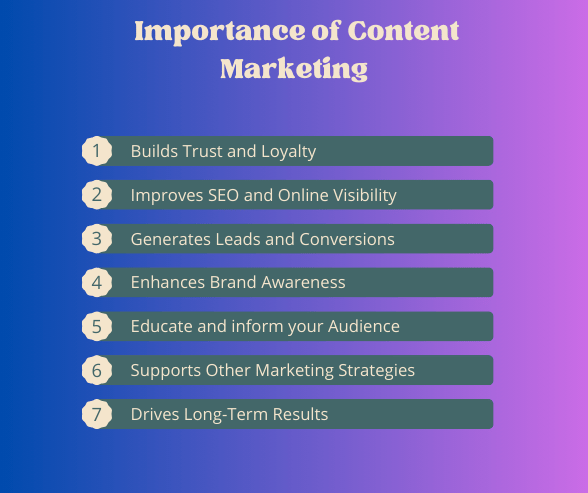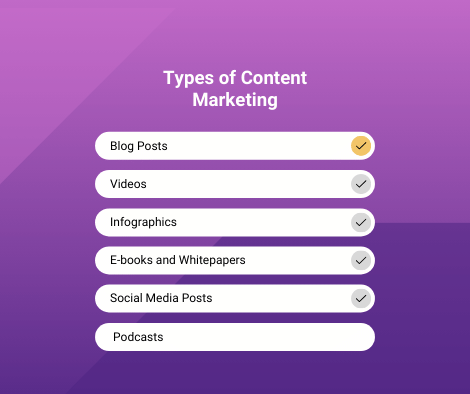Content marketing is a strategic approach focused on creating and distributing valuable, relevant, and consistent content to attract and retain a clearly defined audience ultimately driving profitable customer action. This guide will explore the nuances of content marketing, its importance, and effective strategies, along with real-world examples to illustrate these concepts.
What is Content Marketing?
Content marketing is a strategic approach focused on creating and distributing valuable, relevant, and consistent content to attract and retain a clearly defined audience — and ultimately, to drive profitable customer action. Unlike traditional marketing, which directly promotes products or services, content marketing aims to provide information that educates, informs, or entertains potential customers, thereby building trust and loyalty.
Importance of Content Marketing

Content marketing is not just a buzzword; it’s a critical component of modern business strategy. Its importance spans various aspects of business operations, providing numerous benefits that help companies grow, engage their audience, and achieve their goals. Here’s a detailed look at why content marketing is essential:
1. Builds Trust and Loyalty
Trust is the foundation of any lasting business relationship. Content marketing allows businesses to provide valuable information, insights, and solutions to their audience’s problems. By consistently delivering high-quality content, companies can establish themselves as experts in their field. This expertise builds trust with the audience, making them more likely to choose your products or services over competitors. Trust leads to loyalty, and loyal customers are more likely to make repeat purchases and recommend your business to others.
2. Improves SEO and Online Visibility
Search engine optimization (SEO) is crucial for driving organic traffic to your website. Content marketing plays a significant role in improving SEO. Search engines favor websites that regularly publish high-quality, relevant content. By creating content that incorporates targeted keywords, businesses can improve their search engine rankings. Higher rankings mean more visibility, which can lead to increased website traffic and more opportunities to convert visitors into customers.
3. Generates Leads and Conversions
Effective content marketing can attract potential customers to your website and convert them into leads. By offering valuable content such as blog posts, e-books, webinars, and case studies, businesses can capture the interest of their audience. Gated content, which requires users to provide their contact information to access, is a powerful lead generation tool. Once you have their information, you can nurture these leads through targeted content, guiding them through the buyer’s journey until they are ready to make a purchase.
4. Enhances Brand Awareness
Consistent and relevant content helps increase brand awareness and recall. When your audience regularly encounters your content, they become more familiar with your brand. High-quality content that addresses their needs and interests will make your brand more memorable. As brand awareness grows, so does the likelihood that potential customers will think of your business when they need products or services you offer.
5. Educate and inform your Audience
Content marketing is an excellent way to educate your audience about your products, services, and industry. By providing detailed information and answering common questions, you can help potential customers make informed decisions. Educated customers are more likely to see the value in your offerings and feel confident in their purchasing decisions. Educational content can also reduce the burden on your customer service team by addressing common queries upfront.
6. Supports Other Marketing Strategies
Content marketing is a versatile strategy that can support and enhance other marketing efforts. For example, high-quality content can improve the effectiveness of your social media marketing by providing valuable material to share with your followers. It can also enhance email marketing campaigns by offering engaging content that keeps subscribers interested. Additionally, content marketing can support paid advertising efforts by creating landing pages with compelling content that improves conversion rates.
7. Drives Long-Term Results
Unlike some marketing strategies that provide short-term results, content marketing can drive long-term success. High-quality content has a lasting impact and can continue to attract and engage your audience long after it’s published. Evergreen content, which remains relevant over time, can generate consistent traffic and leads. By building a library of valuable content, businesses can create a sustainable source of organic traffic and engagement.
Key Elements of Content Marketing
1. Audience Research
Understanding your target audience is crucial for creating content that resonates with them. This involves researching their demographics, preferences, pain points, and interests. Tools like Google Analytics, social media insights, and customer surveys can provide valuable data for this purpose.
2. Content Strategy
A well-defined content strategy outlines your goals, target audience, content types, distribution channels, and key performance indicators (KPIs). It ensures that your content efforts are aligned with your business objectives.
3. Content Creation
Content creation involves producing high-quality content that meets the needs and interests of your audience. This can include blog posts, videos, infographics, podcasts, and more. The key is to provide value and maintain consistency in your messaging and tone.
4. Content Distribution
Once the content is created, it needs to be distributed through appropriate channels to reach your target audience. This can include your website, social media platforms, email newsletters, and other online communities.
5. Content Promotion
Promoting your content involves using various tactics to increase its visibility and reach. This can include social media marketing, influencer partnerships, paid advertising, and search engine optimization (SEO).
6. Content Analysis
Regularly analyzing your content’s performance is essential to understand what works and what doesn’t. This involves tracking metrics like page views, engagement rates, lead generation, and conversion rates. Tools like Google Analytics, social media insights, and content management systems can provide valuable data for this purpose.
Types of Content Marketing

1. Blog Posts
Blog posts are one of the most common forms of content marketing. They provide valuable information, answer questions, and address pain points, helping to attract organic traffic from search engines.
2. Videos
Videos are highly engaging and can convey complex information in an easily digestible format. They can be used for tutorials, product demos, customer testimonials, and brand storytelling.
3. Infographics
Infographics combine visuals and text to present information clearly and engagingly. They are particularly effective for sharing statistics, processes, and comparisons.
4. E-books and Whitepapers
E-books and whitepapers are in-depth pieces of content that provide comprehensive information on a specific topic. They are often used to generate leads by offering them in exchange for contact information.
5. Social Media Posts
Social media platforms are ideal for sharing short-form content and engaging with your audience in real-time. They can help drive traffic to your website, increase brand awareness, and foster community engagement.
6. Podcasts
Podcasts are audio content that can be consumed on the go. They are great for sharing insights, interviews, and discussions on relevant industry topics.
Real-World Examples of Content Marketing
Example 1: HubSpot
HubSpot is a leading provider of marketing, sales, and service software. They have successfully used content marketing to establish themselves as thought leaders in the industry. HubSpot’s blog offers valuable insights on a wide range of topics, including marketing, sales, customer service, and business growth. They also provide free resources like e-books, templates, and webinars, attracting a large audience and generating leads.
Example 2: Red Bull
Red Bull is not just an energy drink company; they are also a content powerhouse. Red Bull Media House produces high-quality content, including videos, magazines, and documentaries, focusing on extreme sports and adventurous lifestyles. This content aligns with their brand identity and resonates with their target audience, creating a strong emotional connection and brand loyalty.
Example 3: Grammarly
Grammarly, a writing assistant tool, has effectively used content marketing to grow its user base. Their blog offers valuable writing tips, grammar guides, and productivity advice, catering to a wide range of audiences, from students to professionals. Additionally, Grammarly’s weekly emails provide personalized insights and writing statistics, keeping users engaged and encouraging them to use the tool more frequently.
How to Create a Content Marketing Plan
Creating a successful content marketing plan involves several steps:
1. Define Your Goals
Start by defining what you want to achieve with your content marketing efforts. Common goals include increasing brand awareness, generating leads, improving customer engagement, and driving sales.
2. Identify Your Target Audience
Conduct thorough audience research to understand who your ideal customers are. This will help you create content that addresses their needs, interests, and pain points.
3. Conduct a Content Audit
Review your existing content to identify what has performed well and what hasn’t. This will help you understand what types of content resonate with your audience and identify gaps that need to be filled.
4. Develop a Content Strategy
Based on your goals and audience insights, create a content strategy that outlines your content themes, formats, distribution channels, and promotional tactics. Ensure that your strategy is aligned with your overall business objectives.
5. Create a Content Calendar
A content calendar helps you plan and organize your content production and distribution schedule. It ensures that you consistently publish high-quality content and stay on track with your strategy.
6. Produce and Distribute Content
Create high-quality content that provides value to your audience. Distribute it through the appropriate channels to reach your target audience. Promote your content to increase its visibility and engagement.
7. Analyze and Optimize
Regularly analyze your content’s performance to understand what works and what doesn’t. Use this data to optimize your content strategy and make informed decisions about future content production and promotion.
Conclusion
Content marketing is a powerful tool for building brand awareness, engaging your audience, improving SEO, generating leads, and establishing authority. By understanding your audience, setting clear goals, and consistently creating valuable content, you can develop a successful content marketing strategy that drives results. Remember, the key to effective content marketing is providing genuine value to your audience, ensuring your content is relevant, consistent, and strategically distributed.
